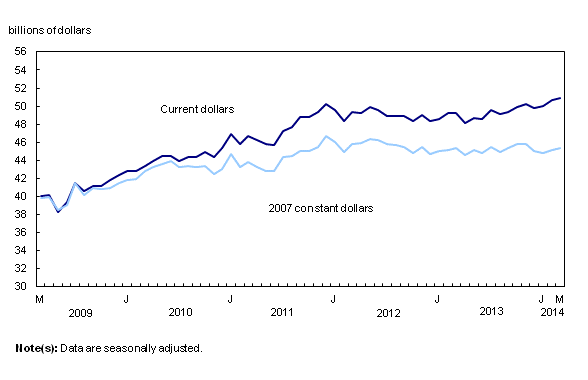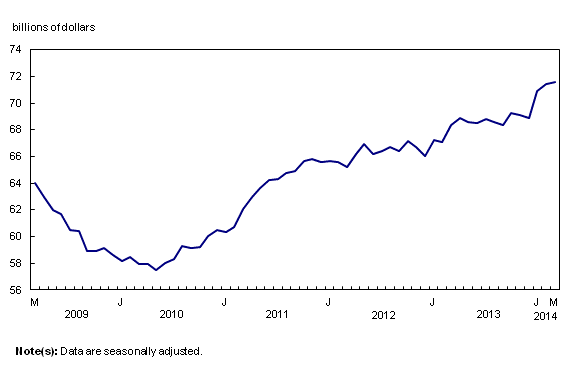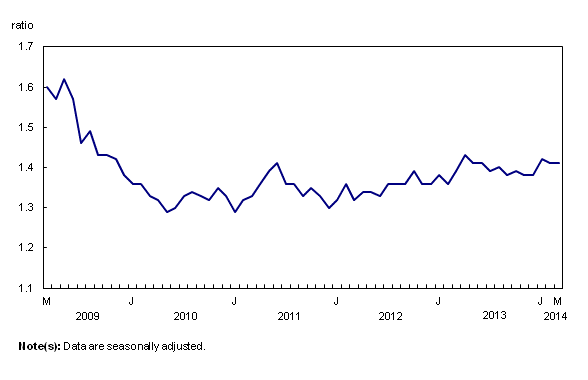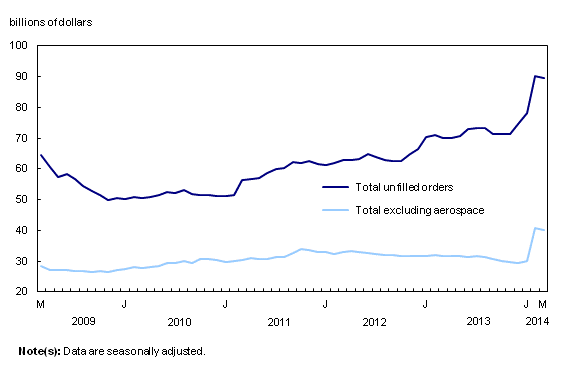Monthly Survey of Manufacturing, March 2014
Archived Content
Information identified as archived is provided for reference, research or recordkeeping purposes. It is not subject to the Government of Canada Web Standards and has not been altered or updated since it was archived. Please "contact us" to request a format other than those available.
Released: 2014-05-15
Canadian manufacturing sales edged up 0.4% to $50.9 billion in March, the sixth advance in seven months. The rise mostly reflected higher sales in the food, machinery, and plastics and rubber products industries. However, these increases were largely offset by declines in the paper, and petroleum and coal products industries.
Sales were up in 11 of 21 industries, representing approximately two-thirds of the manufacturing sector. Both durable and non-durable goods sales increased 0.4%.
Constant dollar sales increased 0.5%, indicating a rise in the volume of goods sold.
Sales rise in the food industry
In the food industry, sales rose 2.1% to $7.8 billion in March, as a result of widespread increases. The largest sales gains were posted by the meat and dairy sub-industries.
Machinery sales increased 3.3% to $3.1 billion in March. In the plastics and rubber products industry, sales advanced 2.7% to $2.1 billion.
Offsetting these increases were a 3.8% decrease in the paper products industry and a 0.8% decline in the petroleum and coal product industry. Some respondents in the paper products industry reported that the decrease in sales was the result of a strike at the Port Metro Vancouver.
Sales rise in five provinces
Sales increased in five provinces in March, led by gains in Quebec, Ontario and Alberta.
A 2.0% rise in sales in Quebec stemmed largely from a 19.9% increase in production in the aerospace product and parts industry. Production in this industry tends to be volatile. Gains in sales were also reported in the primary metal and food industries.
Ontario manufacturers reported a 0.6% increase in sales as a result of the petroleum and coal product, and food industries. Sales of petroleum and coal products were up 7.1%, while food industry sales advanced 2.5% in March.
Alberta sales rose 1.7% in March, reflecting gains in the food and machinery industries.
These increases were partially offset by declines in New Brunswick, Saskatchewan and Newfoundland and Labrador. Lower sales of petroleum and coal products, food, and machinery were reported across these provinces.
Petroleum and coal products behind the increase in inventories
Inventories edged up 0.2% to $71.6 billion, a third consecutive increase. Petroleum and coal products led the advance in March. The paper, wood and food industries also contributed to the rise. Lower inventories in the aerospace product and parts industry partially offset the gains.
In the petroleum and coal products industry, inventories rose 4.5%, reflecting higher levels of raw materials (+19.0%). The increase was partly related to a rise in the price of conventional crude oil, up 12.6% from December according to the Raw Materials Price Index.
Inventories increased 4.9% in the paper industry and 3.3% in the wood product industry. Some manufacturers in the paper industry reported lower sales and higher inventories, in part due to the Port Metro Vancouver strike. Food products also played a part in the overall increase, up 1.6%, the fourth consecutive gain for the industry.
Aerospace products and parts were down 2.2% from their record high in February. This decline offset part of the growth in inventories.
The inventory-to-sales ratio was unchanged at 1.41 in March. The ratio measures the time, in months, that would be required to exhaust inventories if sales were to remain at their current level.
Unfilled orders decline
Unfilled orders fell 0.8% to $89.4 billion, following a 15.4% gain in February. The decrease in March was mostly caused by a 0.8% drop in the transportation equipment industry. Unfilled orders in the transportation equipment industry represent almost three-quarters of total orders.
New orders fell 19.9% to $50.2 billion in March, as they returned to normal levels after a jump in February. New orders are derived by adding sales to the monthly change in unfilled orders.
Note to readers
Estimates of sales of goods manufactured, inventories and orders have been revised back to January 2009 for the unadjusted data, and back to January 2007 for the seasonally adjusted data. These important data changes are the result of the following:
1. Data confrontation between the Monthly Survey of Manufacturing (MSM) and the 2012 Annual Survey of Manufactures and Logging (ASML)
Data confrontation to improve the coherence between MSM data and revised 2011 and preliminary 2012 ASML estimates was completed along with historical revisions to MSM data. This is an annual process to ensure that the data received for the largest units in both the annual and monthly surveys are consistent.
2. Updates to X-12 ARIMA seasonal adjustment models
As in past years, trading-day weights and analysis of trends, levels and moving averages have been updated and revised. This ensures that seasonally adjusted data accurately reflect the latest developments in manufacturing.
3. Revisions to the constant dollar series
The constant dollar series has been updated based on revised MSM data. The volumes data were revised back to January 2007.
4. Review of the MSM confidentiality pattern
A review of the MSM confidentiality pattern was undertaken based on the revised data. Changes to the pattern were made for 2011 to 2014.
Definitions
Monthly data in this release are seasonally adjusted and are expressed in current dollars unless otherwise specified.
Non-durable goods industries include food, beverage and tobacco products, textile mills, textile product mills, clothing, leather and allied products, paper, printing and related support activities, petroleum and coal products, chemicals, and plastics and rubber products.
Durable goods industries include wood products, non-metallic mineral products, primary metal, fabricated metal products, machinery, computer and electronic products, electrical equipment, appliances and components, transportation equipment, furniture and related products and miscellaneous manufacturing.
Production-based industries
For the aerospace industry and shipbuilding industries, the value of production is used instead of sales of goods manufactured. This value is calculated by adjusting monthly sales of goods manufactured by the monthly change in inventories of goods in process and finished products manufactured.
Unfilled orders are a stock of orders that will contribute to future sales assuming that the orders are not cancelled.
New orders are those received whether sold in the current month or not. New orders are measured as the sum of sales for the current month plus the change in unfilled orders from the previous month to the current month.
Data from the April Monthly Survey of Manufacturing will be released on June 13.
Contact information
For more information, contact us (toll-free 1-800-263-1136; 514-283-8300; infostats@statcan.gc.ca).
To enquire about the concepts, methods or data quality of this release, contact Michael Schimpf (613-951-9832; michael.schimpf@statcan.gc.ca), Manufacturing and Energy Division.
- Date modified:





